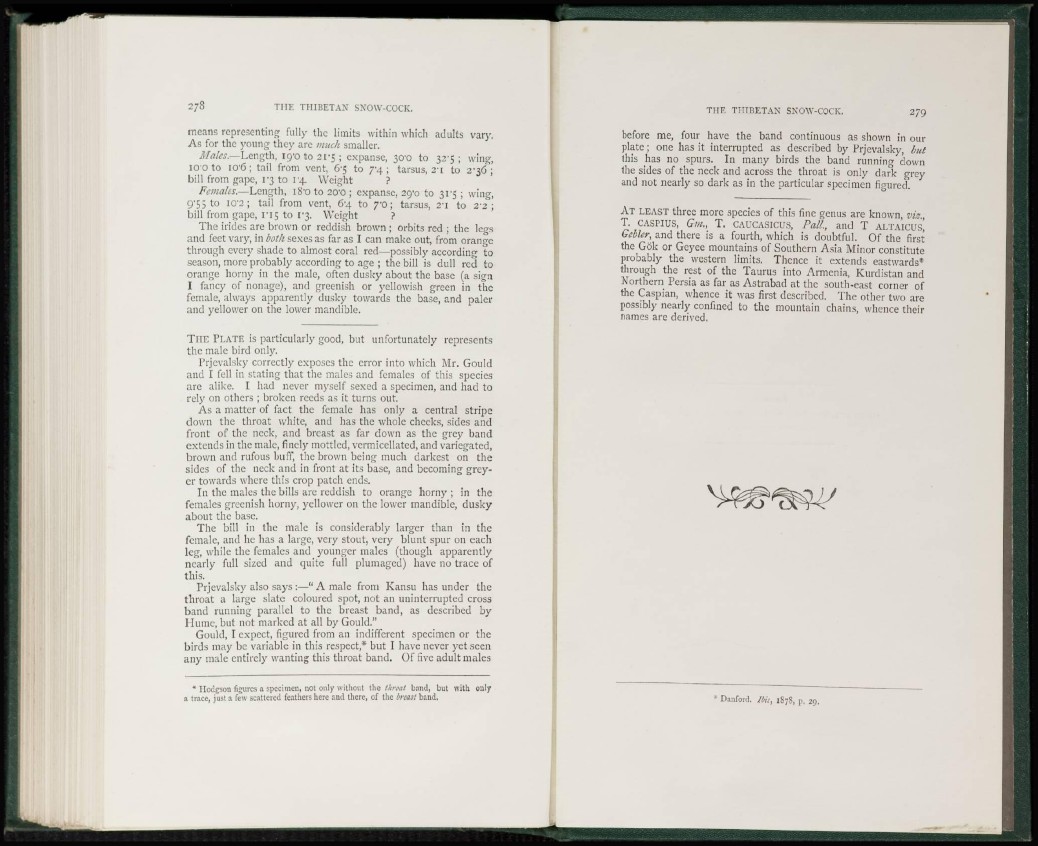
means representing fully the limits within which adults varj-.
As for the young they are much smaller.
Males.—Length, ig'O to 21-5 ; expanse, 30x1 to 32-5 ; wing,
1 0 0 to I0'6 ; tail from vent, 6'5 to TA; tarsus, 2'i to 236 ;
bill from gape, 1*3 to 1*4. Weight ?
Females.—Length, iS'O to 20'0 ; expanse, 20,'o to 31 '5 ; wing,
9-55 to 102; tail from vent, 64 to 7x5; tarsus, 2'i to 2-2;
bill from gape, r i j to l-3. Weight ?
The irides are brown or reddish brown ; orbits red ; the legs
and feet vary, in both sexes as far as I can make out, from orange
through every shade to almost coral red—possibly according to
season, more probably according to age ; the bill is dull red to
orange horny in the male, often dusky about the base (a sign
I fancy of nonage), and greenish or yellowish green in the
female, always apparently dusky towards the base, and paler
and yellower on the lower mandible.
THE PLATE is particularly good, but unfortunately represents
the male bird only.
PrjevaLsky correctly exposes the error into which Mr. Gould
and I fell in stating that the males and females of this species
are alike. I had never myself sexed a specimen, and had to
rely on others ; broken reeds as it turns out.
As a matter of fact the female has only a central stripe
down the throat white, and has the whole cheeks, sides and
front of the neck, and breast as far down as the grey band
extends in the male, finely mottled, vcrmiccllated, and variegated,
brown and rufous buff, the brown being much darkest on the
sides of the neck and in front at its base, and becoming greyer
towards where this crop patch ends.
In the males the bills are reddish to orange horny; in the
females greenish horny, yellower on the lower mandible, dusky
about the base.
The bill in the male is considerably larger than in the
female, and he has a large, very stout, very blunt spur on each
leg, while the females and younger males (though apparently
nearly full sized and quite full plumaged) have no trace of
this.
Prjevalsky also says :—" A male from Kansu has under the
throat a large slate coloured spot, not an uninterrupted cross
band running parallel to the breast band, as described by
Hume, but not marked at all by Gould."
Gould, I expect, figured from an indifferent specimen or the
birds may be variable in this respect,* but I have never yet seen
any male entirely wanting this throat band. Of five adult males
* Hodgson figures a specimen, not only without the throat band, but with only
a trace, just a few scattered feathers here and there, of the breast band.
before me, four have the band continuous as shown in our
plate; one has it interrupted as described by Prjevalsky, but
this has no spurs. In many birds the band running down
the sides of the neck and across the throat is only dark grey
and not nearly so dark as in the particular specimen figured.
A T LEAST three more species of this fine genus are known, vis.,
T. CASPIUS, Gm., T. CAUCASicus, Pall., and T ALTAICUS,
Gebler, and there is a fourth, whicb is doubtful. Of the first
the Gök or Geyce mountains of Southern Asia Minor constitute
probably the western limits. Thence it extends eastwards*
through the rest of the Taurus into Armenia, Kurdistan and
Northern Persia as far as Astrabad at the south-east corner of
the Caspian, whence it was first described. The other two are
possibly nearly confined to the mountain chains, whence their
names are derived.
* Danford. Ibis, 1878, p. 29.